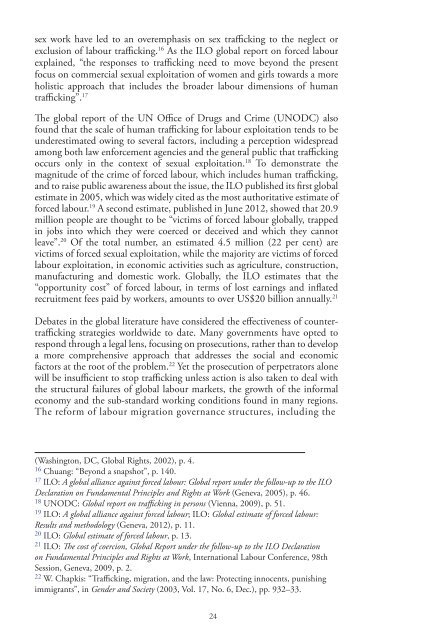Tricked and Trapped: Human Trafficking in the Middle East, ‎pdf 4.1 MB
Tricked and Trapped: Human Trafficking in the Middle East, ‎pdf 4.1 MB
Tricked and Trapped: Human Trafficking in the Middle East, ‎pdf 4.1 MB
Create successful ePaper yourself
Turn your PDF publications into a flip-book with our unique Google optimized e-Paper software.
sex work have led to an overemphasis on sex traffick<strong>in</strong>g to <strong>the</strong> neglect or<br />
exclusion of labour traffick<strong>in</strong>g. 16 As <strong>the</strong> ILO global report on forced labour<br />
expla<strong>in</strong>ed, “<strong>the</strong> responses to traffick<strong>in</strong>g need to move beyond <strong>the</strong> present<br />
focus on commercial sexual exploitation of women <strong>and</strong> girls towards a more<br />
holistic approach that <strong>in</strong>cludes <strong>the</strong> broader labour dimensions of human<br />
traffick<strong>in</strong>g”. 17<br />
The global report of <strong>the</strong> UN Office of Drugs <strong>and</strong> Crime (UNODC) also<br />
found that <strong>the</strong> scale of human traffick<strong>in</strong>g for labour exploitation tends to be<br />
underestimated ow<strong>in</strong>g to several factors, <strong>in</strong>clud<strong>in</strong>g a perception widespread<br />
among both law enforcement agencies <strong>and</strong> <strong>the</strong> general public that traffick<strong>in</strong>g<br />
occurs only <strong>in</strong> <strong>the</strong> context of sexual exploitation. 18 To demonstrate <strong>the</strong><br />
magnitude of <strong>the</strong> crime of forced labour, which <strong>in</strong>cludes human traffick<strong>in</strong>g,<br />
<strong>and</strong> to raise public awareness about <strong>the</strong> issue, <strong>the</strong> ILO published its first global<br />
estimate <strong>in</strong> 2005, which was widely cited as <strong>the</strong> most authoritative estimate of<br />
forced labour. 19 A second estimate, published <strong>in</strong> June 2012, showed that 20.9<br />
million people are thought to be “victims of forced labour globally, trapped<br />
<strong>in</strong> jobs <strong>in</strong>to which <strong>the</strong>y were coerced or deceived <strong>and</strong> which <strong>the</strong>y cannot<br />
leave”. 20 Of <strong>the</strong> total number, an estimated 4.5 million (22 per cent) are<br />
victims of forced sexual exploitation, while <strong>the</strong> majority are victims of forced<br />
labour exploitation, <strong>in</strong> economic activities such as agriculture, construction,<br />
manufactur<strong>in</strong>g <strong>and</strong> domestic work. Globally, <strong>the</strong> ILO estimates that <strong>the</strong><br />
“opportunity cost” of forced labour, <strong>in</strong> terms of lost earn<strong>in</strong>gs <strong>and</strong> <strong>in</strong>flated<br />
recruitment fees paid by workers, amounts to over US$20 billion annually. 21<br />
Debates <strong>in</strong> <strong>the</strong> global literature have considered <strong>the</strong> effectiveness of countertraffick<strong>in</strong>g<br />
strategies worldwide to date. Many governments have opted to<br />
respond through a legal lens, focus<strong>in</strong>g on prosecutions, ra<strong>the</strong>r than to develop<br />
a more comprehensive approach that addresses <strong>the</strong> social <strong>and</strong> economic<br />
factors at <strong>the</strong> root of <strong>the</strong> problem. 22 Yet <strong>the</strong> prosecution of perpetrators alone<br />
will be <strong>in</strong>sufficient to stop traffick<strong>in</strong>g unless action is also taken to deal with<br />
<strong>the</strong> structural failures of global labour markets, <strong>the</strong> growth of <strong>the</strong> <strong>in</strong>formal<br />
economy <strong>and</strong> <strong>the</strong> sub-st<strong>and</strong>ard work<strong>in</strong>g conditions found <strong>in</strong> many regions.<br />
The reform of labour migration governance structures, <strong>in</strong>clud<strong>in</strong>g <strong>the</strong><br />
(Wash<strong>in</strong>gton, DC, Global Rights, 2002), p. 4.<br />
16<br />
Chuang: “Beyond a snapshot”, p. 140.<br />
17<br />
ILO: A global alliance aga<strong>in</strong>st forced labour: Global report under <strong>the</strong> follow-up to <strong>the</strong> ILO<br />
Declaration on Fundamental Pr<strong>in</strong>ciples <strong>and</strong> Rights at Work (Geneva, 2005), p. 46.<br />
18<br />
UNODC: Global report on traffick<strong>in</strong>g <strong>in</strong> persons (Vienna, 2009), p. 51.<br />
19<br />
ILO: A global alliance aga<strong>in</strong>st forced labour; ILO: Global estimate of forced labour:<br />
Results <strong>and</strong> methodology (Geneva, 2012), p. 11.<br />
20<br />
ILO: Global estimate of forced labour, p. 13.<br />
21<br />
ILO: The cost of coercion, Global Report under <strong>the</strong> follow-up to <strong>the</strong> ILO Declaration<br />
on Fundamental Pr<strong>in</strong>ciples <strong>and</strong> Rights at Work, International Labour Conference, 98th<br />
Session, Geneva, 2009, p. 2.<br />
22<br />
W. Chapkis: “<strong>Traffick<strong>in</strong>g</strong>, migration, <strong>and</strong> <strong>the</strong> law: Protect<strong>in</strong>g <strong>in</strong>nocents, punish<strong>in</strong>g<br />
immigrants”, <strong>in</strong> Gender <strong>and</strong> Society (2003, Vol. 17, No. 6, Dec.), pp. 932–33.<br />
24
















